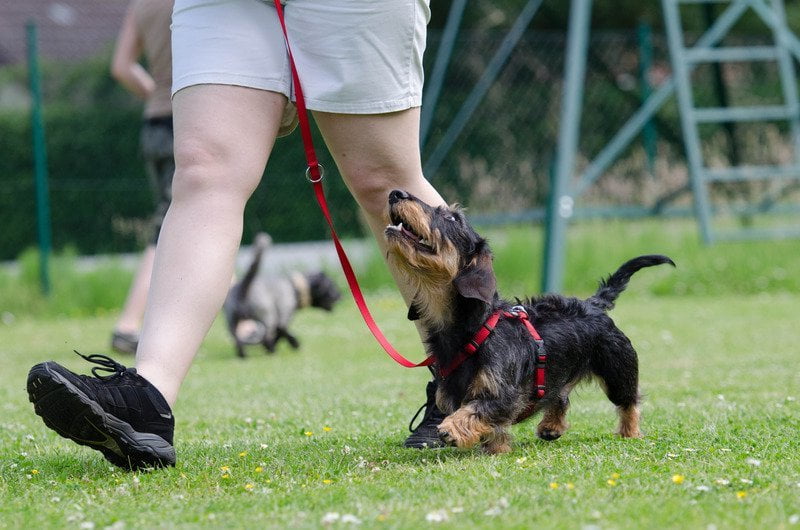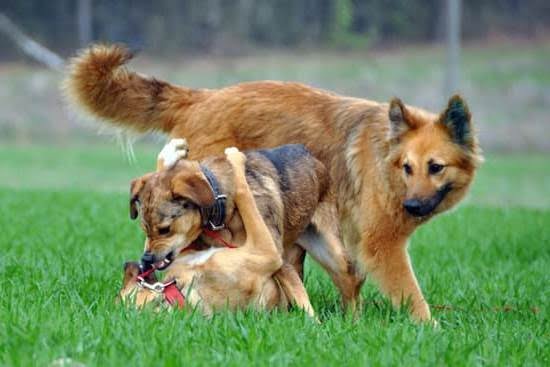Training your dog to stay down is not only important for their safety, but it can also save you from countless headaches and frustration. In this article, we will explore the benefits of teaching your dog to stay down, the potential dangers of a dog that doesn’t obey this command, and provide you with a brief overview of the training process.
One of the main advantages of training your dog to stay down is to ensure their safety. Dogs that jump on people, furniture, or other objects can put themselves at risk for injury.
Additionally, having a well-trained dog that stays down can prevent accidents or incidents from occurring in various situations. Whether you have guests coming over or are taking your dog for a walk, having them remain in a controlled position can help keep them out of harm’s way.
On the flip side, dogs that don’t understand the command to stay down can cause chaos and frustration. They may knock things over, damage furniture, or jump on people who may not be comfortable with such behavior. This lack of control can result in strained relationships between you and your furry friend, as well as with others who interact with your pet.
To train your dog to stay down effectively, it’s crucial to understand the importance of consistency in training. Clear rules and boundaries need to be established from the start so that your dog knows what is expected of them. Mixed messages or inconsistent training methods will confuse your pet and hinder their learning progress.
In the next sections of this article, we will delve deeper into understanding consistency in training and preparing for effective sessions by setting up the right environment. We will also explore how teaching basic obedience commands lays a foundation for “stay down” and provide step-by-step instructions for introducing this command properly. So let’s get started on equipping both you and your pooch with valuable skills that will enhance your bond and daily interactions.
Understanding the importance of consistency in training
Consistency is a crucial aspect of dog training, including teaching your dog to stay down. By being consistent in your approach, you can effectively communicate with your dog and establish clear rules and boundaries. This section will explore the role of consistency in dog training, the importance of setting clear expectations from the start, and how mixed messages can hinder your dog’s learning.
The role of consistency in dog training
Consistency plays a fundamental role in ensuring that your dog understands what is expected of them. Dogs thrive on routine and predictability, so by consistently reinforcing desired behaviors and correcting unwanted ones, you are providing them with guidance and structure. When it comes to teaching your dog to stay down, consistent cues and responses will help them understand when it is appropriate to remain in a lying position.
Establishing clear rules and boundaries from the start
From day one of training, it’s essential to establish clear rules and boundaries for your dog regarding staying down. Consistency begins by defining where they are allowed to be within your home or specific areas. For example, if you don’t want your dog on the sofa or bed, consistently redirecting them to their designated spot reinforces the message that staying down is the expected behavior.
Additionally, consistency extends beyond physical boundaries. It involves consistently using the same verbal cues for commands like “down” or “off” when teaching them not to jump up on furniture or people. Consistently rewarding their compliance with treats or praise further reinforces their understanding of what is expected.
The impact of mixed messages on your dog’s learning
Inconsistency in training can lead to confusion for dogs, as they may receive mixed signals about what behaviors are acceptable. For example, if one family member allows the dog on furniture while another does not, it creates inconsistency which makes it difficult for the dog to understand where they should stay down.
Mixed messages can also occur during training sessions themselves. For instance, if you sometimes reward your dog for staying down and other times simply move on without rewarding, your dog may become unsure about whether they are doing the right thing. Consistency in both verbal cues and rewards helps reinforce the message that staying down is the desired behavior.
By maintaining consistency throughout the training process, you can establish a clear understanding of expectations with your dog. This foundation will make it easier for them to grasp more advanced commands and behaviors, such as the “stay down” command.
Preparing for training
Creating a designated space for training sessions
Before you begin training your dog to stay down, it’s important to create a designated space where you can conduct your training sessions. This space should be free from distractions and provide enough room for your dog to move comfortably. Ideally, choose an area in your home where you can easily control the environment, such as a quiet room or a fenced-in yard.
It’s also important to remove any items that may be tempting for your dog to jump on or interact with during the training session. Clearing the space of toys, food, or other objects will help minimize distractions and allow your dog to focus on the training exercises at hand.
Gathering the necessary training tools and treats
In addition to creating a suitable environment, it’s important to gather the necessary tools and treats before starting your training sessions. Some essential items include a leash, clicker (if using one), treats that your dog finds highly motivating, and any other equipment specific to the training techniques you plan on using.
The type of treats you use is crucial in maintaining your dog’s interest and motivation during the training process. Choose small, soft treats that are easy for your dog to consume quickly so that there are minimal interruptions between exercises. You may consider using special treats that are reserved solely for training purposes to make them more enticing for your dog.
Minimizing distractions and ensuring a calm environment
To set yourself and your dog up for success in the “stay down” training process, it’s important to minimize distractions in the environment as much as possible. This means turning off any loud noises such as TVs or radios and keeping other pets or family members out of sight during training sessions.
Creating a calm environment is crucial in enabling both you and your dog to focus on each other throughout the training process. Dogs are highly sensitive to their surroundings, and a stressful or chaotic environment can hinder their ability to learn and retain information. By ensuring a calm and distraction-free space, you can optimize your dog’s learning experience and make the training sessions more effective.
By following these steps to prepare the right environment, you’ll be well-equipped for successful “stay down” training sessions with your dog. Remember that consistency, patience, and positive reinforcement are key in the training process, so be prepared to invest time and effort into building a strong foundation for this important command.
Basic obedience commands
Teaching your dog basic obedience commands is essential for laying a strong foundation for mastering the “stay down” command. These basic commands, such as “sit” and “down,” play a crucial role in establishing communication and control between you and your furry friend. By mastering these commands, you will set the stage for successfully teaching your dog to stay down.
When teaching your dog basic obedience commands, it is important to start with one command at a time. Begin by teaching your dog the “sit” command, as it is often easier for dogs to learn and provides a solid starting point. Use positive reinforcement techniques such as treats, praise, or toys to reward your dog when they successfully respond to the command.
Next, move on to teaching the “down” command. This command involves instructing your dog to lie down on their stomach with all four legs extended on the floor. Again, use positive reinforcement techniques to reward your dog when they successfully perform the command.
Reinforce these commands consistently and gradually increase the level of difficulty as your dog becomes more comfortable with each instruction. Remember that patience and consistency are key throughout this training process. Consistently practicing these basic obedience commands will help establish discipline and build trust between you and your dog, making it easier for them to understand and master the “stay down” command in the future.
By laying a strong foundation with basic obedience commands, you will enhance both you and your dog’s ability to communicate effectively during training sessions. These foundational skills will aid in preventing confusion or frustration during the process of teaching more complex commands like “stay down.”
With patience, consistency, and positive reinforcement techniques, you can ensure that your furry companion understands and follows these basic obedience cues, setting them up for success in learning more advanced commands like staying down. Remember that building a strong foundation is vital for achieving long-term success in any training endeavor with your beloved pet.
Introducing the “stay down” command
Once you have established a strong foundation of basic obedience commands, such as “sit” and “down,” you can start introducing the “stay down” command to your dog. The “stay down” command is crucial for situations where you need your dog to remain in a lying down position for an extended period of time.
To begin teaching the “stay down” command, follow these step-by-step instructions:
- Start with your dog in a lying down position. Give the verbal cue “stay down” while using a hand signal, such as extending your palm towards them.
- Use a treat to lure your dog into staying down. Place the treat on the ground in front of them, close enough that they are tempted to reach for it but far enough that they cannot snatch it easily.
- As soon as your dog starts to move towards the treat or attempts to get up, calmly repeat the “stay down” command and gently guide them back into the original position.
- Once your dog remains in the down position without attempting to reach for the treat, praise and reward them with the treat and verbal praise like saying “Good stay” or “Good job.”
- Gradually increase the time duration between giving the command and rewarding your dog. Start with just a few seconds at first before gradually working up to longer durations.
Throughout this training process, it’s important to use positive reinforcement techniques such as treats, verbal praise, and petting to encourage desired behavior. Consistency is key – make sure to use the same verbal cues and hand signals each time you give the “stay down” command.
Avoid common mistakes by ensuring clarity in your communication with your dog. For example, avoid using similar sounding words or gestures that might confuse them, and be patient if they do not grasp the concept immediately. Remember that training takes time and repetition for most dogs.
| Tips for Introducing the “stay down” command |
|---|
| Start with short durations and gradually increase |
| Use positive reinforcement techniques like treats and praise |
| Maintain consistency in verbal cues and hand signals |
| Avoid confusing your dog with similar sounding words or gestures |
By using these techniques, you can effectively introduce the “stay down” command to your dog. Remember to remain patient, consistent, and positive throughout the process. With practice and reinforcement, your dog will learn to stay down on command, making it easier for you to manage their behavior in various situations.
Gradually increasing duration and distractions
Once your dog has mastered the concept of staying down, it’s time to start gradually increasing the duration of the command. This will help strengthen their ability to stay down for longer periods of time, even in the presence of distractions. By gradually building up their endurance, you can ensure that they will reliably stay down in a variety of situations.
1. Progressively challenging your dog by increasing the duration of the “stay down” command:
- Start by asking your dog to stay down for just a few seconds before releasing them.
- As they become more comfortable with this duration, gradually increase the time incrementally. Aim for increments of 5-10 seconds at a time.
- Remember to reward your dog with praise and treats when they successfully stay down for the desired duration. This positive reinforcement will motivate them to continue complying with the command.
2. Introducing controlled distractions to test your dog’s consistency:
- Once your dog is able to stay down for longer periods, begin adding controlled distractions into the training sessions.
- Start with mild distractions such as low-level noises or gentle movements.
- Gradually increase the difficulty by adding more distracting elements, such as toys or food placed within their view.
- The goal is to teach your dog how to ignore these distractions and remain focused on staying down until released.
3. Gradually building up your dog’s ability to stay down in different environments:
- To ensure that your dog can generalize this command across different settings, practice in various environments.
- Start in a familiar space where there are minimal distractions and gradually progress to new places with increased stimuli.
- Visit parks, busy streets, or friend’s houses so that your dog learns how to ignore external factors and remain focused on staying down.
- Remember to be patient and adjust your expectations accordingly; progress may be slower in challenging environments.
By gradually increasing the duration of “stay down” and introducing controlled distractions, you are preparing your dog to stay down in real-life situations where there will inevitably be more distractions and longer durations required. Consistency is key throughout this process. Continue reinforcing your dog’s understanding of the command and rewarding them for their successful compliance.
Troubleshooting common challenges in training
Training a dog to stay down can be a rewarding and fulfilling experience, but it is not without its challenges. In this section, we will discuss some of the common obstacles that owners may encounter during the training process and provide techniques for overcoming them.
One common challenge is lack of motivation. Some dogs may not be naturally inclined to stay down or may lose interest quickly. To address this, it is important to use positive reinforcement techniques and make training sessions enjoyable for your dog. This can include using high-value treats, incorporating play into training exercises, and providing plenty of praise and encouragement.
Another challenge that owners may face is distractions. Dogs are easily distracted by their surroundings, especially when they are in new environments or around other animals or people. To overcome this challenge, it is important to gradually introduce distractions during training sessions once your dog has mastered the basic “stay down” command. Start by adding minor distractions, such as toys or low-level noises, and gradually increase the difficulty as your dog becomes more proficient at staying down.
Setbacks are also a common occurrence during dog training. It is important to remember that setbacks are normal and part of the learning process. If your dog struggles with staying down consistently or regresses in their progress, take a step back and revisit previous steps in the training process. Additionally, ensure that you are being consistent with your commands and expectations.
| Common Challenge | Techniques for Overcoming |
|---|---|
| Lack of Motivation | – Use high-value treats
|
| Distractions | – Gradually introduce distractions during training sessions
|
| Setbacks | – Revisit previous steps in the training process
|
Maintaining “stay down” as a lifelong command
Once you have successfully trained your dog to stay down, it is important to understand that this command should be reinforced and practiced throughout your dog’s life. Consistency is key in maintaining any learned behavior, and “stay down” is no exception. By consistently reinforcing this command, you can ensure that your dog understands and follows the instruction in various situations.
To maintain “stay down” as a lifelong command, incorporate it into everyday situations and routines. For example, when you are preparing meals or eating at the dining table, instruct your dog to stay down in their designated spot. This not only prevents them from begging for food but also reinforces their understanding of the command.
Consistency also means regularly practicing the “stay down” command in different environments. Start with implementing it at home, then gradually introduce new locations such as parks or friends’ houses. By doing so, you are teaching your dog that the command applies regardless of the setting.
It is important to troubleshoot any potential regression in your dog’s ability to stay down. If you notice any signs of disobedience or inconsistency, review the training techniques and go back to basics if necessary. Always reinforce positive behavior with rewards and praise while avoiding punishment or frustration.
Remember that training a dog requires patience and persistence. Celebrate the progress you have made so far and continue working on maintaining “stay down” as a lifelong command for your furry companion.
The benefits of having a well-trained dog who can stay down are numerous – from their safety and your sanity to creating a harmonious relationship between you and your pet. Embark on this journey with dedication and enjoy the positive outcomes that come from a well-behaved canine companion.
Conclusion
In conclusion, training your dog to stay down is a crucial skill that not only ensures their safety but also contributes to your own peace of mind. By consistently enforcing the “stay down” command, you can create a harmonious living environment and prevent potential dangers. Through the steps outlined in this article, you have laid a strong foundation for your dog’s obedience and established clear boundaries.
Maintaining consistency in training is essential to reinforce the teachings and expectations you have set for your dog. By establishing rules and boundaries from the start, you create a structured environment that promotes learning and understanding. Avoiding mixed messages will help your dog grasp the concept of staying down more effectively.
Preparing for training is just as important as the actual teaching process. By setting up an appropriate environment free of distractions, providing the necessary training tools, and using positive reinforcement techniques, you ensure that your dog remains focused and receptive to learning.
Remember, training your dog is a journey that requires perseverance and patience. Celebrate every small milestone achieved along the way with enthusiasm. Reflect on how far you and your furry companion have come and appreciate the progress made.
By having a well-trained dog that stays down, you can enjoy various benefits such as increased safety both indoors and outdoors, improved social interactions with other people or animals, and reduced stress levels knowing that your dog can be trusted to follow commands. Encourage others to embark on their own training journeys with their furry companions so they too can experience these positive outcomes.
Frequently Asked Questions
Why won’t my dog stay in down?
There could be several reasons why your dog won’t stay in the down position. Firstly, it’s important to ensure that your dog is physically comfortable in this position. If they are experiencing any pain or discomfort, it may be difficult for them to maintain the down position. Secondly, inconsistency in training can lead to confusion for your dog.
If you haven’t provided clear and consistent cues and rewards, they may not understand what you’re asking of them. Additionally, some dogs have a more active temperament and find it challenging to remain still for extended periods. Patience and consistent training can help address these issues and teach your dog to stay in the down position.
How do you teach a long down stay?
Teaching a long down stay requires patience and incremental progressions. Start by teaching your dog a solid “down” command using positive reinforcement techniques such as treats or praise. Once your dog is reliably following this command, introduce the concept of duration by gradually increasing the amount of time they remain in the down position before receiving their reward.
Initially, start with brief intervals (a few seconds) before releasing them from the down position and gradually work your way up to longer timeframes (several minutes). Consistency is key – reinforce the behavior consistently over multiple training sessions until your dog has learned to stay in the down position for an extended period.
How do you train a dog not to jump on people?
To train a dog not to jump on people, it’s essential to provide consistent guidance and redirect their behavior towards more appropriate actions when greeting others. To begin with, teach your dog an alternative behavior that is incompatible with jumping, such as sitting or even just having all four paws on the ground when being greeted.
Practice this alternate behavior regularly using positive reinforcement methods like treats or praise whenever they successfully perform it during greetings.

Welcome to the blog! I am a professional dog trainer and have been working with dogs for many years. In this blog, I will be discussing various topics related to dog training, including tips, tricks, and advice. I hope you find this information helpful and informative. Thanks for reading!





